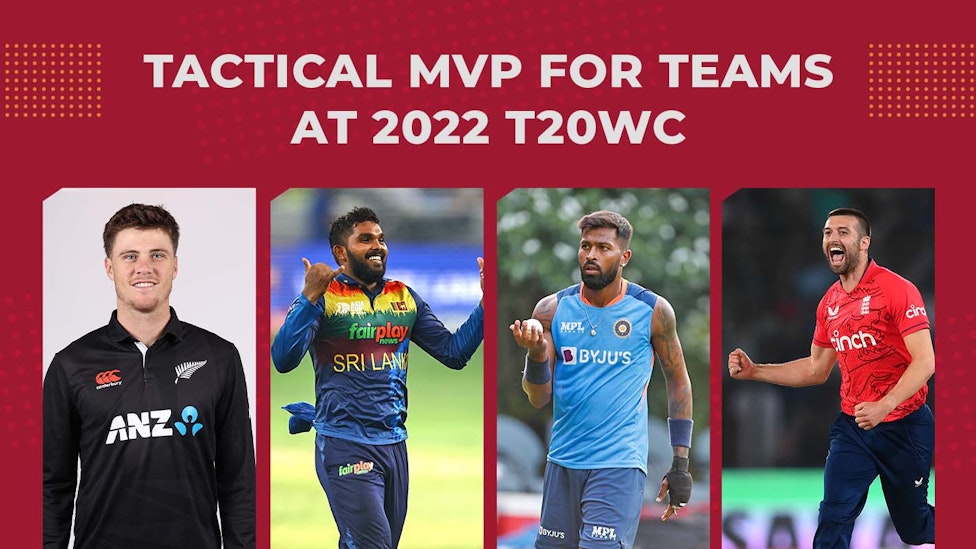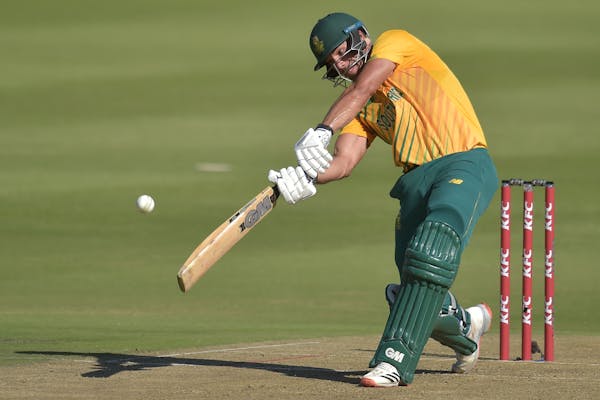 OPINION
OPINIONVery often, MVPs are considered to be the Most Valuable Player of a team, either a batter who scores a truckload of runs or a bowler who only knows how to pick wickets. But in this article, we will be focusing on players without whom their sides would be handicapped — the tactical MVPs.
Sri Lanka – Wanindu Hasaranga
We start with the obvious ones, Wanindu Hasaranga is a no-brainer option for Sri Lanka. He is one of those rare cases of tactical MVPs also being the real MVPs for their side, Hasaranga’s skillset is irreplaceable. Just a look at the numbers will tell you a story without many words. In the 2021 T20WC, Hasaranga struck at 148.75 with the bat, averaged 9.75 with the ball, picking up the most wickets in the competition.
Since that tournament, he’s picked up 19 wickets, striking every 12.9 deliveries, and he's batted with a strike-rate of 137.2, his display in the Asia Cup showing how important he is. Both his primary and secondary skills are good enough for him to feature purely on merit.
And with Sri Lanka’s top-order struggling for the big shots, Hasaranga’s place becomes extremely crucial. Remove Hasaranga from the setup, you will know how dark the tunnel is.
West Indies – Jason Holder
Jason Holder is an interesting case. While in T20 cricket, he has forged a mark, he has struggled in T20Is in recent times. But even then, he averages 23 with the ball, with as many wickets. But the one thing that has been a real concern is his batting, where he averages just 11.80 at 116.83, numbers that are terribly underwhelming.
But remember this article is all about that balance. If Holder does miss out, imagine how the Windies setup would work out. Not so efficiently, right? Very often, he is their new-ball bowler, he is that batting floater, a very good fielder and their death-over bowler. Surely, Windies need him to find his feet.
Australia – Adam Zampa
Glenn Maxwell seems to be the obvious name, isn’t it? But we then dived deep to find out how undervalued Adam Zampa is for Australia. In the T20 World Cup last year, he was the second highest wicket-taker, only behind Hasaranga. Now, how we see it is this way, without Maxwell’s impact – both with the bat and the ball – Australia won the tournament last year. In the last eight T20Is, Maxwell’s scores read: 19, 16, 1, 0, 6, 0, 1, 8.
Then how about Warner? Again, Warner is perhaps a big MVP himself but something that Australia don’t quite possess is a wicket-taking option as proficient as Zampa.
Over the last two years, Zampa has picked up 40 wickets for Australia, with a strike-rate of 18.3, only behind Hasaranga, Shamsi and Sodhi in international cricket. But the point is, remove Zampa from the setup and you will naturally see an Australian side struggling to pick up wickets.
England – Mark Wood
2022, Optus Stadium, in a high-scoring thriller, Mark Wood walked away with a spell of 3/34. While it might not have been better than Nathan Ellis’ numbers, his impact was perhaps the game-changer, with crucial wickets of Warner, Marcus Stoinis and Tim David. His absence has weakened the English bowling unit to the tilt.
In his and Jofra’s absence, England’s average bowling speeds have dropped down to 135 kmph, and have looked less threatening on surfaces that are flat. Perth was one, if not for Wood, England would have struggled. Which only makes him England’s tactical MVP going into the World Cup, a pacer who can clock onwards of 145kmph.
South Africa – Aiden Markram

How? Well, even in the absence of Shamsi, South Africa can still find a balance, with Markram bowling his off-spinners against long boundaries in Australia. His role at No.4 is perhaps the biggest differentiator for the Proteas, considering Temba Bavuma’s form.
Pakistan – Shadab Khan
Shabab Khan for the most part of his T20I career was underutilised, as a batter. But as Dan Weston pointed out in the Wrong'Uns with Weston show, Shadab’s all-round abilities for Pakistan are unparalleled. The tri-series made it evident that using the right-hander at No.4 is an option that Pakistan can greatly benefit from. In just nine innings, the right-hander has scored at a strike-rate of 161.7.
Why is he a tactical choice over the others?
Well, Pakistan’s setup is such that they lack a genuine all-rounder in the setup. If Shadab misses out, like he did early on in the England series, Pakistan have to either strengthen their batting or bowling. He is the biggest luxury in Pakistan’s sleeves for this World Cup.
Bangladesh – Afif Hossain
Shakib Al Hasan, surely that is a tactical X-factor that is enough for this list, right? Well, we did think about it for a while but this was the name that ticked all the boxes – Afif Hossain. Not only is Afif a left-handed batter but also an off-spinning option that Bangladesh could very well utilise in the T20 World Cup in Australia.
Simple, in 2022, the left-hander averages 32.83 while striking at 124, with two fifties, in a team that has been struggling to find their feet in the 20-over format. Going into a global event in conditions like Australia’s, Afif might be that X-factor for the Tigers.
New Zealand – Finn Allen
Numerous times in the past, we have seen New Zealand start with Martin Guptill, owing to the experience that he possesses. But in the recent past, the change from Guptill to Allen has been a big positive for the BlackCaps. Since his debut, no opener from the top ten sides has scored at a better strike-rate than Allen (160.9). Hence, it is imperative what Allen has to offer for New Zealand.
Chuck that, look at the influence of the right-hander’s in terms of finding the boundaries, it is a no-brainer for him to be New Zealand’s tactical MVP. Now, it is up to the Kiwis.
Afghanistan – Rashid Khan
Rashid Khan is fairly an obvious choice. He is an MVP any which way you look at it. Apart from being Afghanistan’s first global superstar, Rashid also can bowl more than decently, with 118 T20I wickets, averaging 14.21 at a strike-rate of 13.6. If that isn’t enough, he can even whack a ball, striking at 120 with the bat.
What’s the best way to figure out a tactical MVP? Just remove them from the setup, if you think that the team literally can’t do anything, then there is your answer. With Rashid, it is pretty evident.
India – Hardik Pandya
This is possibly something that we thought about a lot, ask us why? Suryakumar Yadav, in simple terms. But the more we thought about it, Hardik Pandya being the tactical MVP made a lot of sense. Hear me out, he is India’s genuine all-round option, a power-hitter and a second 140kmph option. It would make literally no sense to talk about a life without Pandya, we have all seen that, haven’t we?
India without Hardik is literally not a genuine title-contender. Post his IPL exploits, the all-rounder has picked up 12 wickets, with a strike rate of 23 with the ball. But his abilities to bounce out opposition will come as a bigger value in the absence of Jasprit Bumrah. Not to forget, with the bat, he averages 31.33 with a strike-rate of 147.6. So, he is basically irreplaceable, isn’t he?